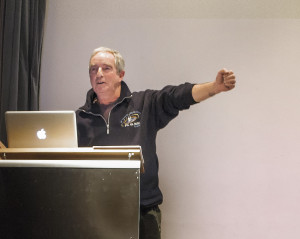February 11, 2013
Sky this Month : February / March 2013
Martin Male
The objects detailed below will be visible with binoculars or to the un-aided eye.
First of all, there is a handy tip for judging distances in the sky. If you extend your arm and make a fist, holding your arm up to the sky, your fist will cover approximately 10° of the sky.
The Sun
On 11th February, the Sun rose at 07:22 and set at 17:08 with an altitude at noon of 25° (in London). In one month, on 11th March, the Sun will rise at 06:23 and set at 17:58, 1 hour 50 mins longer and will attain an altitude at noon 35°. The Sun’s altitude in December at solstice is just 15°, whilst at the June solstice, it is 62°. At the Spring Equinox on 20th March 2013, we experience equal night & day length. The Sun only rises due east and sets due west around Equinoxes.
The Moon
The New Moon was on 10th February 2013, with the next Full Moon on 28th February 2013. On February 18th, there is an example of a Lunar Occultation, where the leading edge of the Moon covers a background star. This will occur on February 18th at 18:36, with a 6th magnitude star. The dark preceding edge of the Moon covers the star, and the star appears to ‘snap out’!
Winter Constellations
These constellations (e.g. Orion) are high in the sky at dusk. Later in the night, Leo and the “Spring” constellations will rise in the east.
Planets
Mercury is visible just after sunset around the 15th-20th February, with a 15° maximum elevation. Mars is low down in west at sunset, but you’ll be lucky to find it! Venus, Uranus & Neptune are too close to the Sun this month. Jupiter in the constellation of Taurus is unmistakable and can be seen high in the south in the early evening. Saturn rises just before midnight and is due south around 0500, so it is for early birds, but is worth looking out for. If you have a telescope, look for the rings; these have about 19° tilt, so look for the planet’s shadow on them. Look also for Titan – it orbits Saturn in just under 16 days – you might be able to make out its orange colour. It has a thick atmosphere of nitrogen, methane & ethane and it rains hydrocarbons there!
Asteroids
Asteroid 2012 DA14 was discovered from Spain in 2012 and will make a close pass, about 20,000 miles away, on Friday 15th February. The object is estimated to be about 50 metres across, but it will not be visible without binoculars. This object is about as reflective as toner ink. Estimates vary, but if it ever did hit Earth, it is expected it would be similar to the 1908 Tunguska event in Siberia (i.e. it would destroy a city but not the planet!). The asteroid is unlikely to be confused with man-made satellites, as they will be much faster and/or be in Earth’s shadow. See here for further details.
Meteors
There are no notable meteor showers this month.
Comets
Comet PanSTARRS C/2011 L4 could be a spectacular object from the middle of next month onward, but it might prove to be a damp squib! It will be low down in the sky W / WNW, from mid-March onwards
Star of the Month
Arcturus: This is a visibly orange star, with a surface temperature of 4530°K (the Sun is 5778°K). It is 20-times the diameter of our Sun and approximately 100-times as bright. It is 37 light years away and its motion through the galaxy is unusual and may be from a merger with another galaxy. As it is rising in the evening sky now, I think of this as an indicator that Spring is not too far away!
Posted under: Flamsteed, Sky This Month



You must be logged in to post a comment.